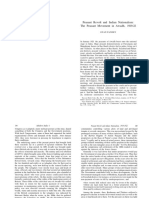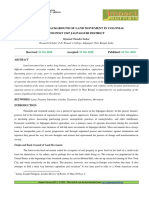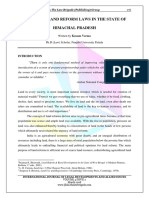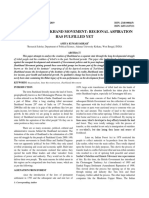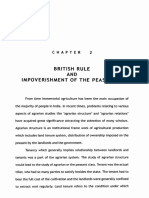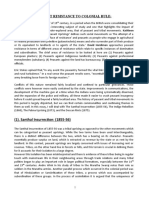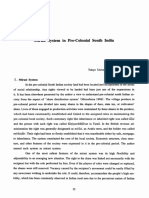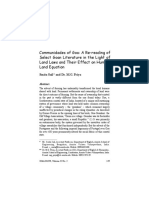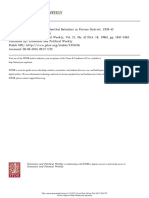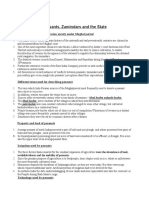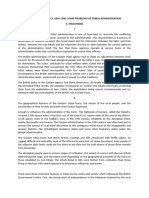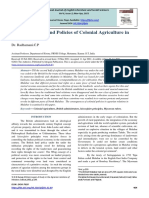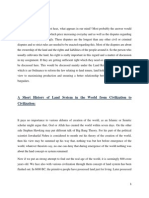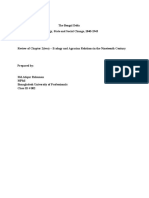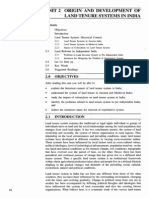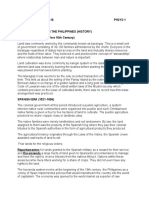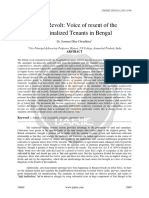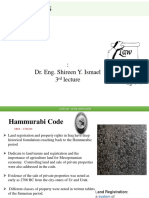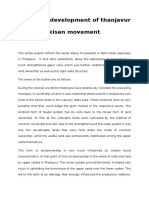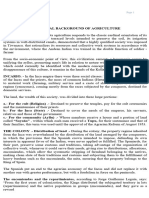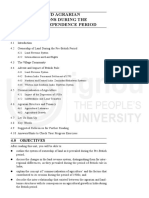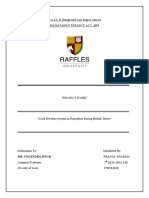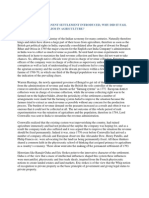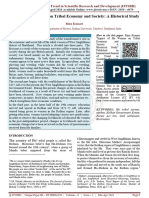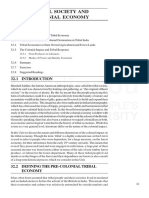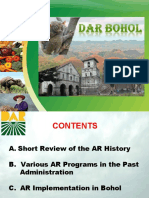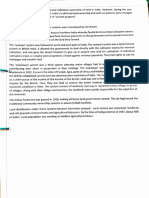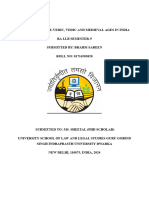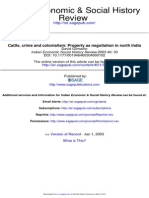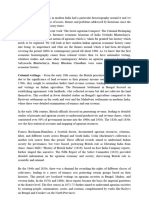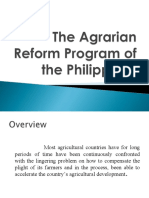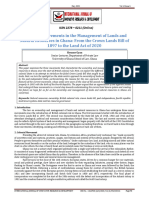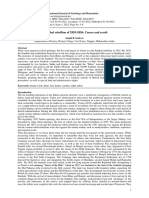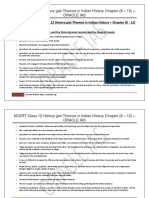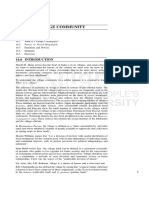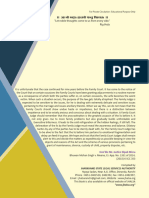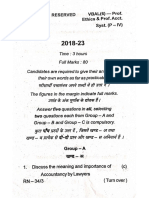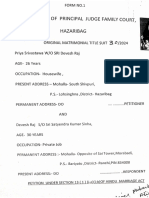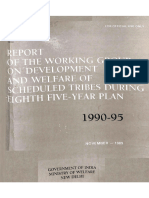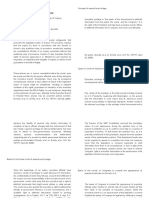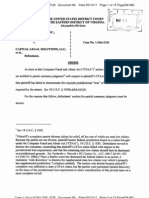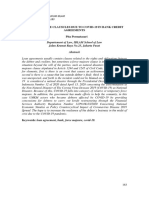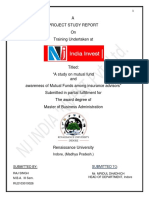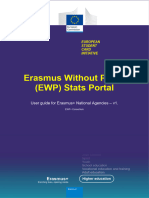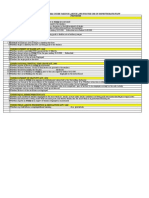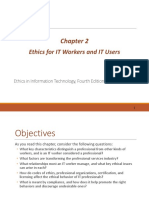Landrightsin Jharkhand
Landrightsin Jharkhand
Uploaded by
baraankush15Copyright:
Available Formats
Landrightsin Jharkhand
Landrightsin Jharkhand
Uploaded by
baraankush15Original Description:
Original Title
Copyright
Available Formats
Share this document
Did you find this document useful?
Is this content inappropriate?
Copyright:
Available Formats
Landrightsin Jharkhand
Landrightsin Jharkhand
Uploaded by
baraankush15Copyright:
Available Formats
See discussions, stats, and author profiles for this publication at: https://www.researchgate.
net/publication/334603401
Land rights in Jharkhand
Article · July 2019
CITATIONS READS
0 6,493
1 author:
Ambrish Gautam
Amity University Jharkhand
10 PUBLICATIONS 13 CITATIONS
SEE PROFILE
All content following this page was uploaded by Ambrish Gautam on 22 July 2019.
The user has requested enhancement of the downloaded file.
Journal of Cultural and Social Anthropology
Volume 1, Issue 1, 2019, PP 10-15
Land Rights in Jharkhand: an Analysis of Chhotanagpur
Tenancy Act
Dr. Ambrish Gautam
Assistant Professor, Amity University, Ranchi
*Corresponding Author: Dr. Ambrish Gautam, Assistant Professor, Amity University, Ranchi,
Email: agautam@rnc.amity.edu
ABSTRACT
The graph of the incessant conflict between the state and the people in Jharkhand on the issue of ownership
and the usage of livelihood resources has once again shoot up in recent years. Consequently the governance
of the state has entered into a critical phase. Resource alienation by both state and private parties has
created social unrest, at a scale unprecedented in the post independence period. People’s struggle for
survival exhibits two dimensions. The struggle without has as usually an impact on the struggle within.
However, the gender struggle within the society has now taken a different turn as compared to the previous
phases. Suppressing females in the name of ‘cleansing’ the society by the dominant males has now been
replaced by the loud demand of the females for their resource rights. An effort has been made in this paper
to understand the nature of these conflicts, in term of time and space, and also to come out with a set of
recommendations for civil society interventions with a view to resolve the conflicts by democratic means.
Keywords: CNT, Tribe, Munda, Manki, Bhuinhar, Khuntkattidar
INTRODUCTION Primary or Jungle State
Jharkhand has witnessed distinct relationships In this, the same relationship continued to exist
between cultivators and the land that they but with a difference; the cultivators paid tribute
cultivate or use as pasture in a sequence or chanda to the Rajas as the „protectors‟, not as
spanning over a period of about four hundred the owners of the land.
years. The Hindu Rajas introduced the Pauranic
The changing relations may be seen in all its Hinduism and the Muslim Jagirdars brought in
dimensions, economic, political and cultural, the popular traits of Islam in the forest clad
economic being the primary one. Which are as upland. The villages were considered to be
follows? loosely connected to the larger state system of
the plains.
The Norms
British Colonial Period
In the pre-state time norm were, „he who sows,
reaps the yield‟. But the land belonged to the The cultivators became tenants and are forced to
lineage or in some cases to the village pay regular tax to the landlords. People lost
community. control and ownership over their ancestral land,
forest and water. Land was put under
That was the time people cleared the forest, proprietorship. The crown retained ownership of
established villages and prepared cultivable the land. Newly formed class of Zamindars
fields in cooperation with each other. Families
became the harbinger of Brahminic Hinduism.
were the usufructs of the land, not the owner. Christianity was introduced to the original
Land was considered to a part of the Mother holder of land in the process of their struggle for
Nature that demands regular propitiation of the land rights. Colonial political system engulfed
guardian spirits. Jharkhand.
Swidden and settled agriculture gave rise to a
Post Independence Period
distinct cultural life along with the spiritual
significance of land. The new settlements The cultivators continue to remain tenants and
developed a political system of decision making pay tax to the state, the ultimate the owner of the
about the usage and management of land. land.
Journal of Cultural and Social Anthropology V1 ● I1 ● 2019 10
Land Rights in Jharkhand: an Analysis of Chhotanagpur Tenancy Act
Throughout these four stages of transformation population. This is misleading because it is the
of the relationship between the cultivators and figure of the Scheduled Tribes only. But if one
the land the issue of land rights of the cultivators notices the percentage of cultivators the actual
remained the most contentious issue. percentage of the Adivasis of Jharkhand would
be revealed.
TERRITORIAL IDENTITY
Obviously, there is no wander that the outsiders
The territory under the present state of of all hues would oppose this so called policy of
Jharkhand was a part of a much larger „paternalism and isolation‟ after independence.
topography of Great Central Indian Forests A steep demand against it emerged from the
(Habib: 1982) that occupied whole of central quarters of bureaucracy and political parties,
India between the Gangetic plains in the north anthropologists and economists, even in the
and the Deccan plateau in the south. Even earliest time of the nations „tryst with destiny‟.
before 13th century it was called Jharkhand Verier Elwin stood for the continuation of this
(Mathew: 2003), the land of the forests, without,
policy for the protection of the tribes from their
however, having any definite territorial identity. rapacious neighbors and under his advice
The region remained outside the pale of the Jawaharlal Nehru proclaimed his Tribal
empires and kingdoms of the plains till the Panchsheel for the administration of the
emergence and consolidation of primary states, Scheduled Areas with the same spirit.
or jungle states, in the 17th century (Sinha:
1987). Among them the largest one, the MAKING OF THE CNT ACT 1908
Chhotanagpur Raj was the first to be recognized
The greatest event in the process of buying
by the Mughals. The other neighboring smaller
peace in Chota Nagpur by the colonial rulers
ones were forced to be the part of the empire in
was the making of the Chota Nagpur Tenancy
the following years. All of them put together
Act 1908. All along, the process of colonial law
came to be known as Jharkhand, a Persian word,
making was marked by a common feature;
and became a part of the „Subah of Bangal‟. The
administrative reform coupled with a new
British East India Company received the
legislation always happened in response to
Dewani, responsibility of tax collection, from
popular revolts against the colonial rule. Rent
the Mughal Emperor Shah Alam II in the year
Act of 1859 came in the wake of indigo riots,
1765 of the subah or the province. „It is in the
Bengal Tenancy Act 1885 came after the
year 1770 that the first entry of British in
peasant revolt of 1872-73, and Chotanagpur
Chotanagpur seems to have taken place‟ (Roy:
Tenancy Act 1908 was not an exception to that
1912). But it took them about one and half
rule. This was the final truce between the rulers
century to establish complete control over the
and the rebelling indigenous peoples. The
land. To break the steep resistance of the people
process that began with the Wilkinson‟s Rules
the colonial state divided the land into four parts
found a mature shape in this Act. For the
and attached them to the provinces of Bihar,
historians it „innovated many provisions to give
Bengal, Orissa and the Central Province (Later
protection to the aboriginal tenants and became
was called Madhya Pradesh).
a piece of model legislation‟ (Singh. 1985). J. C.
The princely state of Chhota Nagpur was the Jha quoted Reid, „The Government was obliged
first to be brought under the administration of to give salutary effect to the principles, which
the East India in 1834; it was called the South- the authority of the Agent enforced in the early
West Frontier agency. The Kolhan Government days of the South West Frontier Agency‟ (Jha.
Estate was added to it in 1838. Later, emerged 1964). For Das Gupta, „CNT marked a
two divisions, Chota Nagpur (with the area of watershed in the history of the colonial state
the Agency) and the Santal Parganas (in 1855 intervention in land relations in Chota Nagpur‟
first and then with a smaller size in 1857). (Das Gupta. 2011). However, one should not
Present Jharkhand is the combination of these overlook the fact that CNT was the outcome of
two divisions. In the post colonial period the the gory Munda rebellion that ended in 1900. To
government, in response to the popular demand understand this process of reaching an
of a separate state of Jharkhand with all the agreement with the indigenous peoples that took
three parts, curved out only the Bihar part of about a century demands brushing up of our
Jharkhand as a separate state in 2000 and knowledge of history of the same period. British
christened it by the same name. Now it is often East India Company introduced the Permanent
said that the Tribals are in minority in Jharkhand Settlement of land with the highest bidder of
comprising only about 26.1% of the total annual rent in 1793 and replaced the old
11 Journal of Cultural and Social Anthropology V1 ● I1 ● 2019
Land Rights in Jharkhand: an Analysis of Chhotanagpur Tenancy Act
landlords, Rajas, Jagirdars etc. by a new class of Roy observed, “…the jagirdars and thikadars …
landlords called the Zamindars. The rent that the continued their campaign against the aboriginal
highest bidder promised to pay to the Company peasant-proprietors steadily though silently. As
was fixed permanently. He was to keep one Coronel Dulton wrote in 1871, „it was then that
tenth of the rent he had collected from the the greatest disturbance of peasant proprietary
cultivators as his share of the booty. In addition tenure occurred.‟ (Roy 1912)
to that the Zamindars was to be awarded the
Immediately after the Sepoy Mutiny the Civil
benefit of any future increase in the value
Procedure Code (Act VIII of 1859) was
through expansion of cultivation of fallow land.
extended to Chota Nagpur with a provison that
For the first time in the history of Bengal (that
“no sale of immovable property shall take place
included Bihar, Orissa and Chota Nagpur), the
without the sanction of the Commissioner”. But
proprietary rights of land went to these
the Board of Revenue declined to introduce it
Zamindars, whom Rabindranath Tagore called
and suggested the modification of the existing
„parasites of the society‟, and Edmund Burke,
procedure in accordance with the spirit of the
„the wickedest of the human race‟ (Majumdar.
Act. As a result of that the seizure of land in
2011). However, Cornwallis, the architect of the
order to obtain payment of money owed was not
new system, was sure of the success of it, he
acted upon but the sale of lands in execution of
said, „the proprietors (the new class of
rent decrees continued to be exercised with the
Zamindars) of the land should be attached to us
previous sanction of the Commissioner in each
from motives of self interest‟ (Majumdar. 2011).
case.
Moreover, in addition to the fixed rent the
Permanent Settlement also introduced a rigid After the “conflicts and affrays that had
principle of paying the rent in cash and thereby occurred in Sonepur and Basia in the year 1858,
brought „money‟ into the agrarian system. The were suppressed, … the authorities at length
new system also introduced the British system saw that the only effectual mode of preventing a
judiciary and replaced the old ones largely based repetition of such affrays and riots would be to
on customs. The peasant was reduced to the remedy the grievances that had given rise to
status of semi-serfs. them. And accordingly, under the Government
orders, dated the 15th April 1858, Lal Loknath
The extension of the Permanent Settlement of
Sahi, a local Zamindar and a Sub-Assistant
1793 to Chota Nagpur created a huge social and
Commissioner, was deputed to prepare a register
political turmoil. It played havoc to the very
of all Bhuinhari lands” (Roy. 1912). However,
existence of the original settlers of the land. K.
he died even before completing a small part of
S. Singh rightly observed that the Zamindari
his task in 1862. Actually the whole effort was
system shook the Munda society by its roots.
half-heartedly planned and was withdrawn
During the period between 1779 – 1833, Sharat
subsequently after his death. Thus the dispute
Chandra Roy observed, “… the country was in a
between the landlords and tenants broke out
most distracted condition. The worst of all evils
afresh after that. “And at length, with a view to
were, however, the ceaseless aggression against
an authoritative settlement of the title of
the ancient landed rights of the aboriginal
Bhuinhari lands, the Chotanagpur Tenures Act
population, which led to repeated
was passed by the Bengal Council on the 26th
insurrections…” (Roy 1912). On the face of a
July 1869” (Roy. 1912). The background of the
steep resistance put up by the indigenous
act was formed, with the realization of the fact
peoples (the so-called aboriginal tribes, as the
of the Munda‟s relationship with his ancestral
colonial administers identified them) the
land, on the part of the colonial rulers. S. C. Roy
Cornwallis‟ system had to retreat and, as we
quoted a top level officer‟s account, “The value
have mentioned in the previous chapter, a rather
the Bhoonears attached to their land is very
liberal approach of Monroe and Matcliff was
great: nothing will ever reconcile them to be
adopted. The new concept of „peasant
deprived of it. They are always buried in the
proprietor‟ was accepted to pacify the revolting
villages where their Bhoonearee lands are
people.
situated, and even if they die at a distance, their
J. C. Jha maintained that, „The inauguration of hairs consider it a necessary act of piety to
the South West Frontier Agency marked the transport their bones to their own village, that
beginning of a twenty year period of peace in they may be buried in the Harsali, or burying
the tribal area, a peace made complete after the ground of the village. The disturbances in
incorporation of Singhbhum in the Agency in Nagpor in 1832, was caused by no one cause so
1837‟ (Jha. 1964). However, Sharat Chandra much as the dispossession of the Mundas and
Journal of Cultural and Social Anthropology V1 ● I1 ● 2019 12
Land Rights in Jharkhand: an Analysis of Chhotanagpur Tenancy Act
the Mankis, who are the Bhoonears of Sonepur, (Interestingly this was what the PESA Act 1996
of their lands, and until the Bhoonears are contains). The government found these claim
protected in the possession of their lands, we and prayer unreasonable and extravagant under
never can be certain of the peace of the the changed condition of the country and
country.” (Roy. 1912) necessarily rejected. However, even though the
government came out with new Legislatures,
Under the operation of the act a large number of
none of them grappled with the most crying
disputes were heard and disposed. But soon the
grievances of the people. Chota Nagpur
expectations of the framers of the act as to its
Landlord and Tenant Act of 1869 failed to effect
success of removing all grievances and allaying
any appreciable improvement in the relations
all disturbances were found out to have been but
between the Mundas and their landlords.
illusive. Roy pointed out the reasons. Firstly, the
act came too late. “The results of the Bhuinharee „After 1882 the free sale of landed property let
settlement under Bengal Act II 1869 revealed to a recurrence of serious abuses and of
how great had been the havoc committed on the consequent disturbances, such as Sardari Larai
Bhuinharee lands in the half a century that of the 1880s and the Birsait movement of 1895-
preceded the passing of the Act. Hoffmann‟s 1900‟ ( Jha. 1964:239) The “Birsaite Rebellion”
observation under Nalis or the popularly upheld “Ulgulan” (the great
tumult) forced the colonial state to look for a
The second reason was that the Zamindars and
„radical cure for the discontent amongst the
Thikadars were successful in befooling the
Mundas, which had now become chronic‟ (Roy:
Bhuinhars by spreading the news that the
1912:204). The outcome was the Chota Nagpur
purpose of the survey was to enhance the rent
Tenency Act 1908. The Survey and Settlement
and therefore, the Bhuihars should refrain from
operation began in 1902 covering 1,846 square
declaring their actual possession of land. They
miles of the then Ranchi district.
even enticed the Bhiunhars with „good amount
of pork and liquor‟. The missionaries who even Colonial state largely recognized the rights of
translated the government orders in Mundari the tribal (aboriginal) communities over their
language to convince the Bhuinhars to declare land as the „original reclaimers‟ of the same and
their actual possession of land were blamed to called them „peasant proprietors‟. They were put
be the agents of the British administration and at par with the Zamindars, the class that was
most of the non Christian Bhuinhars believed it. created as proprietors. They were categorized as
As a result of that a huge portion of land under the Bhuinhars and the Khuntkattidars.
the possession of the descendants of the original
„Kumar Suresh Singh summarized the salient
setters of the village was not recorded in their
features of the act, „The Act marked the end of a
names and eventually was claimed by the
century of agrarian strife and was an event of
Zamindars and Thikadars.
capital significance. It was the culmination of
The third cause was the non-recognition of the legal and administrative measures taken so far to
Bhuinhars‟ rights over the forest, timber and remove the agrarian discontent: the Chotanagpur
fruit-bearing trees and the exclusion of the Landlord, and Tenants Procedure Act of 1879,
Khuntkatti tenure out of the scope of the Act. and finally, the Commutation Act of 1897 were
only stepping stones to it. Its object was to
Thus the conflict between the Zamindar and
“supersede and consolidate the Acts in force in
Thikadar combine and Mundas and Uraons of
the division, to improve and amplify the
Ranchi district continued with sporadic
procedure and to improve and complete the
skirmishes and scuffles. However, at this stage a
substantive law by embodying in it certain
new form of movement emerged with the help
provisions of the Bengal Tenancy Act and some
of the missionaries, Known as the “Sardari
additional provisions” which affirmed “local
Agitation” or “Muluki Larai”. The Christian
customary rights and usages” (Singh: 1985).
social leaders, called the “Sardars” took the path
Legal sanctity to the customary rights for the
of peaceful agitation by taking recourse to the
first time extended to women‟s legal rights to
colonial legal system. Memoranda and petitions
land and its produces.
flooded the courts of law. The common point
was that the whole of Chota Nagpur belonged to One must remember in this context that one of
the Mundas and the Uraons, therefore, the the important contributors to the farming of the
government must give them back their lost land CNT Act 1908 was Reverend Father John
and allow to form themselves into village Baptist Hoffman, S. J., a German Missionary
communities directly under the government. who devoted his life first to know the people
13 Journal of Cultural and Social Anthropology V1 ● I1 ● 2019
Land Rights in Jharkhand: an Analysis of Chhotanagpur Tenancy Act
and then to stand firmly on the side of them in However, so far as the safeguard of “Khuntkatti
the days of their utter suffering. He submitted right” was concerned, the Act came rather late
„The Special Memorandum on the Land System for more than “nineteenths of the race”. Only
of the Munda Country‟ along with Mr. E. Lister, 156 villages could be secured as intact Mundari
ICS, to the government to understand the Khuntkatti villages.
Munda people and their social structure,
The Act and the results of the Settlement fell
customs and land system. On receiving the first
short of some Mundas‟ expectation; many
edition of the Chota Nagpur Landlord and
points of leakage in the Act remained:
Tenant Procedure Act (the precursor of the
moneylenders were as active as ever, and the
CNTA) with a letter of appreciation of his
alienation of land could not be totally stopped
contribution dated 6th March 1905, Hoffman
(Singh: 1987).
wrote in his great Encyclopaedia Mundarica,
“For more than a hundred years the Mundas CNTA RECOGNIZED THE FOLLOWING
were culminated as savages or semi-savaes, CATEGORIES OF LANDHOLDERS
whose claims were too exorbitant and absurd, to Mundari Khunt-Kattidar
be listened to, as stubborn rebels, whom nobody
could satisfy, and therefore, justly subjected to The descendants of the Munda founder of the
severe military repraisalsm as „saar kol‟s, who village are called thus. He along with his lineage
were fit for nothing but for carrying burdens and brothers owns the village including the land and
be serfs. And now after a cruel martyrdom that the forest within its boundary. They do not pay
lasted all too long , their claims have been tax but rent for the land.
recognized officially as having been perfectly According to the Settlement report of 1927 there
right, and their land system appears as one of were only 156 intact and 449 broken Mundari
the wisest creations of prehistoric Khunt-Katti villages survived in RANCHI
times…Therefore, the act is a justification of District. In the intact villages the land is under
and a rehabilitation of the highest moral value. the control of the Mundas only whereas in the
“But the benefits of the Act were not limited to broken ones people who are not the descendant
this rehabilitation of the race, nor to the small of the original founder, including non-tribals,
number of those whose ancient rights were now have occupied land.
officially recognized.
Bhuinhari Tenure
They extended to absolutely all raiyats of Chota
These are lands in non-Mundari areas, which
Nagpur…“Since up to that time … no raiyat
have been reclaimed and brought under
could for a single day, be sure that he would be
cultivation by original claimants of the village
left in undisturbed possession of the fields the
or their descendants. They enjoy the status of
robbers have so far left to him because he had
tenure-holders, and hold lands either rent free or
not a scrap of written evidence that they were
really in his cultivation. at quit rent fixed in perpetuity. The total area of
the Bhuinhari land according to the last
Any day a Zamindars or one of his creatures Settlement was 215 sq. Miles.
might turn up in court and claim one or more of
those fields as being in his own Raiyats Holding Khunt-Katti Rights
cultivation…“And now at least every field was In non-Mundari areas, excluding the villages
measured and registered in the name of those covered by Bhuinhari land, the descendants of
whom the settlement found in actual possession, the original founders of the village in occupation
and every raiyat received a so-called parchai of the land cleared from the forest are known as
enumerating the fields in his cultivation. This raiyats having Khunt-Katti rights. The number
put an end to all vexatious lawsuits… of Khunt-Katti tenancies recorded in the last
“Thus the settlement literally resembled a calm, survey was 938.
sunny morning after a long destructive Raiyats
hurricane, which had reduced all the Mundas to
Excluding the above-mentioned privileged tribal
extreme poverty and had thrown hundreds of
tenures, there are other raiyati lands held by
thousands for ever far away from their own dear
non-Khuntkattidar tribal and other castes.
country… “To me who had been forced to
witness and feel the horrid sufferings of the With the gradual breakdown of the tribal land
Mundas for so many years, it afforded one of system due to the invasion of the non-tribals in
the greatest joys of my life” (Hoffman. 1950) the region, these tribal tenures are gradually
Journal of Cultural and Social Anthropology V1 ● I1 ● 2019 14
Land Rights in Jharkhand: an Analysis of Chhotanagpur Tenancy Act
becoming extinct, and now a majority of the Indigenous Peoples Struggle for Autonomy in
holdings are ordinary raiyati lands. Under the India. IWGIA, Copenhagen
raiyat a system of subletting is also prevalent in [2] Bohannan, Paul J. 1963. „Land‟, „tenure‟ and
the region. „Land Tenure‟ in Danial Biebuyck (ed.),
African Agrarian Systems. London
CONCLUSION [3] Das Gupta, Sangjukta. 2011. Adivasi and the
Thus it can be said that the Mundari Khuntkati Raj: Socio-economic Transition of the Hos,
system of Ranchi is not the same as that of 1820-1932. Orient BlackSwan, New Delhi
Singhbhum. In Ranchi the Khuntkattidars enjoy [4] Hoffman, J. B. in collaboration with Emelen,
such rights as fixed rent, rights in forests and A. V. 1950. Encyclopaedia Mundarica.
waste. But in Singhbhum the rent could be Government Printing Press, Patna
enhanced and there are no khuntkatti rights over [5] Habib, Irfan. 1982. The Cambridge Economic
unreclaimed land. (Singh,:1985) Adivasis (not History of India: Volume 1, c.1200-c.1750,
just the Scheduled Tribes) have walked a long University of Cambridge, Cambridge
University Press.
way in their interaction with the colonial and
Indian nation state. [6] Jha, J.C. 1964. The Kol Insurrection of
Chotanagpur, Thacker, Spink and Co., Calcutta
But they could not be integrated with the state Majumdar, Asok. 2011. The Tebhaga
system of either kind. Is it their fault or they Movement: Politics of Peasant Protest in
have been systematically kept outside the state Bengal. 1946-50. Aakar, Delhi
process by the builders of the state? This is a big [7] Roy, S.C. 1912. The Munda and their country,
question in-front of the democratic government. Asia Publishing House, Calcutta
And it is essential to make specific policies for [8] Singh, K.S. 1987. Chotanagpur Raj:
their development, so the present context of Mythology, Structure and Ramifications, in
pathalgarhi kind of act can be stopped. Surajit Sinha (ed.) Tribal Polities and State
Systems in Pre-Colonial Eastern and North
REFERENCES Eastern India, Published for Centre for Studies
[1] Areeparampil, Mathew. 2003. Historical Basis in Social Sciences, Calcutta, by K.P. Bagchi &
of the Name Jharkhand in Munda, R. D. and Co. Calcutta Singh, K. S. 1985. Tribal Society
Bosu Mullick, S. edited Jharkhand Movement: in India. Monohar, New Delhi
Citation: Ambrish Gautam." Land Rights in Jharkhand: an Analysis of Chhotanagpur Tenancy Act”,
Journal of Cultural and Social Anthropology, 1(1), 2019, pp.10-15.
Copyright: © 2019 Ambrish Gautam. This is an open-access article distributed under the terms of the
Creative Commons Attribution License, which permits unrestricted use, distribution, and reproduction in
any medium, provided the original author and source are credited.
15 Journal of Cultural and Social Anthropology V1 ● I1 ● 2019
View publication stats
You might also like
- History of The Church of PentecostDocument22 pagesHistory of The Church of PentecostBoachie Agyemang-Adolf100% (1)
- Financial Closing Process Checklist by Said IslamDocument8 pagesFinancial Closing Process Checklist by Said IslamAndi Tri JatiNo ratings yet
- Pandey Peasant Revolt PDFDocument28 pagesPandey Peasant Revolt PDFanjaleekriNo ratings yet
- Format. Hum - Origin and Back Ground of Land Movement in Colonial and Post 1947 Jalpaiguri DistrictDocument10 pagesFormat. Hum - Origin and Back Ground of Land Movement in Colonial and Post 1947 Jalpaiguri DistrictImpact JournalsNo ratings yet
- The Ghalla Dher Movement Agrarian Agitation in North West Frontier Province During The First Congress Ministry 1937 39Document16 pagesThe Ghalla Dher Movement Agrarian Agitation in North West Frontier Province During The First Congress Ministry 1937 39Ahmad JaveedNo ratings yet
- Kusum VermaDocument18 pagesKusum VermaVanshika SainiNo ratings yet
- History of Jharkhand MovementDocument4 pagesHistory of Jharkhand MovementbibinNo ratings yet
- 08 Chapter 2Document57 pages08 Chapter 2davidizanagiNo ratings yet
- Peasant UprisingsDocument11 pagesPeasant UprisingsHarsh SinghNo ratings yet
- Miras I SystemDocument12 pagesMiras I SystemShashikiran KolarNo ratings yet
- Communidades of Goa A Re Reading of SeleDocument16 pagesCommunidades of Goa A Re Reading of SeleFaith DiasNo ratings yet
- Land Tenure Holding Land of The State or of A Proprietor On Specific Terms andDocument13 pagesLand Tenure Holding Land of The State or of A Proprietor On Specific Terms andsumonpanthaNo ratings yet
- Partition OperationPolo SreemoyeeDocument15 pagesPartition OperationPolo SreemoyeeAditi VermaNo ratings yet
- Santhal RebellionDocument2 pagesSanthal RebellionAjeet KumarNo ratings yet
- Life & Livelihood in Santal PargansDocument5 pagesLife & Livelihood in Santal Pargansdrsudiptab24No ratings yet
- Santhal 1Document20 pagesSanthal 1nnriame08No ratings yet
- Peasant Movements in India and Its Impact On British AdministrationDocument16 pagesPeasant Movements in India and Its Impact On British AdministrationupendraNo ratings yet
- 06 Chapter 1 PDFDocument18 pages06 Chapter 1 PDFKaustubh SharmaNo ratings yet
- Notes CH 8 MughalDocument8 pagesNotes CH 8 MughalArtworx Gzb100% (2)
- The Ganjam Agency 1839 to 1900Document13 pagesThe Ganjam Agency 1839 to 1900TCRTM AP-VisakhapatnamNo ratings yet
- The Formations and Policies of Colonial Agriculture in MalabarDocument5 pagesThe Formations and Policies of Colonial Agriculture in MalabarIJELS Research JournalNo ratings yet
- A Short History of Land System in The World From Civilizaion To CivilizationDocument25 pagesA Short History of Land System in The World From Civilizaion To CivilizationNabilBariNo ratings yet
- The Bengal Delta Ecology, State and Social Change, 1840-1943Document3 pagesThe Bengal Delta Ecology, State and Social Change, 1840-1943mit global solutionsNo ratings yet
- Block 1 MRDE 003 Unit 2Document21 pagesBlock 1 MRDE 003 Unit 2Viswanadh PeriNo ratings yet
- Agrarian Reform PHDocument12 pagesAgrarian Reform PH다옌No ratings yet
- A Separate TelanganaDocument5 pagesA Separate TelanganaParth PatelNo ratings yet
- Cprc-Iipa 22Document30 pagesCprc-Iipa 22Amit Kumar MaitiNo ratings yet
- Pabna Revolt Voice of Resent of The Marginalized Tenants in Bengal Ijariie14660Document3 pagesPabna Revolt Voice of Resent of The Marginalized Tenants in Bengal Ijariie14660Devansh SNo ratings yet
- Land Laws:: Dr. Eng. Shireen Y. Ismael 3Document13 pagesLand Laws:: Dr. Eng. Shireen Y. Ismael 3Wassan IdreesNo ratings yet
- Historical Development of Thanjavur Kisan MovementDocument9 pagesHistorical Development of Thanjavur Kisan MovementgowthamNo ratings yet
- Land Grants Early MediaevalDocument4 pagesLand Grants Early MediaevalArish IsaNo ratings yet
- History12 - 4 - Mughal Empire and Agrarian Society PDFDocument28 pagesHistory12 - 4 - Mughal Empire and Agrarian Society PDFRavi Garchar0% (1)
- Indian Economic Social History Review-1979-Henningham-53-75Document24 pagesIndian Economic Social History Review-1979-Henningham-53-75Dipankar MishraNo ratings yet
- Agricultural AccountingDocument83 pagesAgricultural AccountingScribdTranslationsNo ratings yet
- Understanding Peasant Society in Indian ContextDocument8 pagesUnderstanding Peasant Society in Indian ContextritaNo ratings yet
- EditedDocument45 pagesEditedanjalisingh93688No ratings yet
- Unit 4Document14 pagesUnit 4Ravi KushNo ratings yet
- Rta PranavDocument8 pagesRta PranavGaurav GehlotNo ratings yet
- Why Was The Permanent Settlement IntroducedDocument4 pagesWhy Was The Permanent Settlement IntroducedTeresa WalterNo ratings yet
- Finall Prsentation DraftDocument5 pagesFinall Prsentation DraftMitali PandeyNo ratings yet
- Impact of Ho Women On Tribal Economy and Society A Historical StudyDocument6 pagesImpact of Ho Women On Tribal Economy and Society A Historical StudyEditor IJTSRDNo ratings yet
- Unit 32Document14 pagesUnit 32Jigyasa SinghalNo ratings yet
- Early Village AdministrationDocument22 pagesEarly Village AdministrationAruna DeviNo ratings yet
- DAR Seminar PowerpointDocument124 pagesDAR Seminar PowerpointJubelyn Mesias RevanoNo ratings yet
- Land OwnershipDocument18 pagesLand OwnershipAmitava DasNo ratings yet
- Land Laws PSDADocument4 pagesLand Laws PSDABrahm SareenNo ratings yet
- EDITED Agrarian Law and Social Legislation NarrativeDocument9 pagesEDITED Agrarian Law and Social Legislation NarrativeCrizziaNo ratings yet
- Cattle, Crime and Colonialism Property As Negotiation in North IndiaDocument25 pagesCattle, Crime and Colonialism Property As Negotiation in North IndiaUsman AhmadNo ratings yet
- Agrarian Economy FinalDocument4 pagesAgrarian Economy FinalShreyashi KashyapNo ratings yet
- Chapter Iv - Social, Political, Economic and Critical Issues in Philippine HistoryDocument6 pagesChapter Iv - Social, Political, Economic and Critical Issues in Philippine HistoryRica Mel MaalaNo ratings yet
- The Agrarian Reform Program of The PhilippinesDocument39 pagesThe Agrarian Reform Program of The PhilippinesBautista, Jhon Chris G.No ratings yet
- PresentationDocument11 pagesPresentationpreetsinghjjj100% (1)
- IntroductionDocument7 pagesIntroductionsoumyaNo ratings yet
- Three MovementsDocument9 pagesThree MovementsimmlarryNo ratings yet
- History of LawkatiDocument4 pagesHistory of LawkatiTedNo ratings yet
- Hsslive-Colonialism & Countryside - 241015 - 130651 - 010726Document56 pagesHsslive-Colonialism & Countryside - 241015 - 130651 - 010726mrindiakumar6465No ratings yet
- Class 12 History NCERT Summary - Part 2Document46 pagesClass 12 History NCERT Summary - Part 2JYOTISH RAJNo ratings yet
- Comprehensive Agrarian Reform Program (CARP)Document11 pagesComprehensive Agrarian Reform Program (CARP)Guki SuzukiNo ratings yet
- Unit 16Document8 pagesUnit 16saqueeb111No ratings yet
- Assault on a Culture: The Anishinaabeg of the Great Lakes and the Dynamics of ChangeFrom EverandAssault on a Culture: The Anishinaabeg of the Great Lakes and the Dynamics of ChangeNo ratings yet
- Land Divided by Law: The Yakama Indian Nation as Environmental History, 1840-1933From EverandLand Divided by Law: The Yakama Indian Nation as Environmental History, 1840-1933No ratings yet
- Family Law JudgementDocument300 pagesFamily Law Judgementbaraankush15No ratings yet
- UntitledDocument14 pagesUntitledbaraankush15No ratings yet
- DocScanner Sep 4, 2024 4-53 AMDocument8 pagesDocScanner Sep 4, 2024 4-53 AMbaraankush15No ratings yet
- 348Document249 pages348baraankush15No ratings yet
- Proverbs Bible Study QuestionsDocument77 pagesProverbs Bible Study Questionsjdrockey100% (2)
- Pandemic Unemployment Assistance UpdateDocument2 pagesPandemic Unemployment Assistance UpdateMacy Berning100% (2)
- Legislative Department Summary DiscussionDocument32 pagesLegislative Department Summary Discussionalbemart100% (1)
- Animators at Law, Inc. v. Capital Legal Solutions, 10cv1342 (E.D. Va. May 10, 2011)Document15 pagesAnimators at Law, Inc. v. Capital Legal Solutions, 10cv1342 (E.D. Va. May 10, 2011)Venkat BalasubramaniNo ratings yet
- Flash BIOS Update (Readme)Document2 pagesFlash BIOS Update (Readme)Agung Sutiadi DNo ratings yet
- Module 1: Cyber Security FundamentalsDocument6 pagesModule 1: Cyber Security FundamentalsAravind VbkNo ratings yet
- Education As A Tool of Liberation From Corrupt Leadership in Africa: A Comparative Study Between Plato's Allegory of The Cave and Julius Nyerere's Allegory of The MountainDocument14 pagesEducation As A Tool of Liberation From Corrupt Leadership in Africa: A Comparative Study Between Plato's Allegory of The Cave and Julius Nyerere's Allegory of The MountainAJHSSR JournalNo ratings yet
- Chapter 2 - Normal PartnershipDocument18 pagesChapter 2 - Normal PartnershipmaiNo ratings yet
- Amendment of ConstitutionDocument3 pagesAmendment of ConstitutionAditi SinghNo ratings yet
- Chapter 1 - Understanding Business EthicsDocument23 pagesChapter 1 - Understanding Business EthicsJihan RafiqaNo ratings yet
- CC 6406 - ELECTRICAL LOW VOLTAGE CABLE TEST REPORT - Rev 3Document2 pagesCC 6406 - ELECTRICAL LOW VOLTAGE CABLE TEST REPORT - Rev 3samboopathiNo ratings yet
- Em Waves and Transmission Lines - June-2015Document4 pagesEm Waves and Transmission Lines - June-2015Veerayya JavvajiNo ratings yet
- Pita Permatasari 163-183 PDFDocument21 pagesPita Permatasari 163-183 PDFDistrict9 ApartmentNo ratings yet
- Mao Zedong's Infamous Mango CultDocument4 pagesMao Zedong's Infamous Mango CultsrdjanNo ratings yet
- Raaj SipDocument76 pagesRaaj SipAdarsh VermaNo ratings yet
- The French and Indian War Guided - ReadingDocument3 pagesThe French and Indian War Guided - ReadingalvernazjNo ratings yet
- Electronic Ticket Receipt: Flight 1 - Bandar Seri Begawan (BWN) To Melbourne (MEL)Document5 pagesElectronic Ticket Receipt: Flight 1 - Bandar Seri Begawan (BWN) To Melbourne (MEL)ilhamina.athirahNo ratings yet
- Patent o TolerancijiDocument3 pagesPatent o TolerancijiZachary ColonNo ratings yet
- EWP Statsportal Guide For NAs Nov23Document17 pagesEWP Statsportal Guide For NAs Nov23scribd.com1223No ratings yet
- 1984-07-30 (Iepa)Document2 pages1984-07-30 (Iepa)John DodgeNo ratings yet
- J 2024 SCC OnLine SC 1878 Sumeer Vsalegalin 20241019 050413 1 9Document9 pagesJ 2024 SCC OnLine SC 1878 Sumeer Vsalegalin 20241019 050413 1 9prasang292No ratings yet
- Islamic Directorate of The Philippines Vs CADocument2 pagesIslamic Directorate of The Philippines Vs CARM Mallorca100% (1)
- Checklist For Form 22A (Active Form) : Information Required Sl. NoDocument3 pagesChecklist For Form 22A (Active Form) : Information Required Sl. NoGuru100% (1)
- Inspection ProformaDocument6 pagesInspection ProformachhatarashalNo ratings yet
- Ashraf Ali Thanvi PDFDocument26 pagesAshraf Ali Thanvi PDFaditya_2kNo ratings yet
- People Vs GalanoDocument1 pagePeople Vs GalanoAngelo NavarroNo ratings yet
- Chapter 2 Ethics For IT Workers and IT UserDocument45 pagesChapter 2 Ethics For IT Workers and IT UserjustdourworkNo ratings yet
- 04a_TP_Prelim_Period-ACCE102A_-_with_answerDocument9 pages04a_TP_Prelim_Period-ACCE102A_-_with_answervela.aromaticaaNo ratings yet


